“People think that being a zookeeper is just playing with animals all day long. Actually, it’s caring for them and making their lives meaningful. And getting visitors to connect with them. That’s amazing to do.” – Wendi, Forest+Wetlands keeper, Northwest Trek
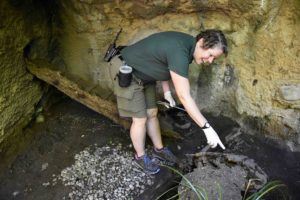
7:30am
Wendi arrives at Northwest Trek for the early shift. On this mid-summer morning it’s a fine time to be working outside in a forest, but in winter it’s dark, cold and frequently icy. But for Wendi, that’s all part of the job. As one of the keepers in the Forest/Wetlands habitat, she cares for otters, beavers, badgers, wolverines, skunk and raccoons – and they don’t ever skip breakfast. It’s one of her first chores, after checking email and notes from the late-shift keepers the night before. She also checks in on any animals in the veterinary clinic.
Then it’s time for cleaning rounds. With each animal safely in their inside dens, Wendi hoists herself onto the rock wall and over into the otter habitat. Armed with a pan and scraper, she starts looking for otter poop.
“Keepers take care of every aspect of an animal’s life – physical, mental, health care,” she explains.
Daily poop-scooping may not be glamorous, but it’s absolutely essential for monitoring an animal’s well-being. As Wendi scours the yard she’s picking up all sorts of clues about the otters: how much they’re chewing branches, whether they’ve dropped any fur, what’s in the poop (anything from undigested objects to parasites). Finally, she scatters the first enrichment item of the day: Cheerios.
“All animals need new things to challenge and interest them,” says Wendi. “We give them several every day. Otters are smart and curious, so we get creative. Animal fur, play or food items, new scents, branches, or just rearranging things in their space.”
8am
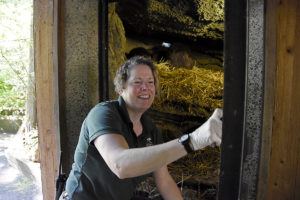
Yard clean, Wendi climbs back out, bringing the ladder with her and making triple-sure nothing has fallen from a pocket to entice curious otters. She empties the poop scoop, then makes her way around the front to clean the glass windows before park guests arrive.
Then she unlocks a door in the rock wall and heads inside to where two energetic otters are waiting. Inside their den is a green, otter-sized tube – all the keepers work on training behaviors to stimulate animals and help with their care, and this tube is for the otters to hold completely still while they receive vaccinations or give blood samples. Wendi unlocks and raises the chute door, and the otters race like quicksilver out into the pool, scrambling up the bank and discovering the Cheerios within seconds.
Wendi watches for a few moments, smiling. A family wanders up, and two boys remark loudly on the fishy smell.
Wendi grins.
“You know what that smell is?” she says gleefully. “It’s otter poop – look!”
“Eww!!” say the boys, fascinated.
“And you know why it smells fishy?” Wendi continues, relishing the teaching moment. “Because that’s what otters eat – fish.”
“Ohh!” they exclaim in unison, and press noses to the freshly-cleaned glass.
“One of the most satisfying parts of this job is seeing otters be otters,” says Wendi. “What’s even more satisfying is seeing visitors see otters be otters. That helps me deal with any frustrating stuff in life.”
8:30am
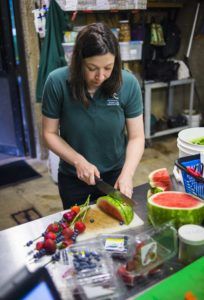
Wendi moves on into the badger habitat, emptying and refilling the water tray, scooping more poop, laying out branches as enrichment.
“Hi, dude!” she exclaims, spotting an animal visitor – a Western toad, perched on a stump.
She cleans out yesterday’s enrichment, a pile of leaves in the den, and heads behind the scenes. All around are enormous pumps and pipes, the filtration system for the otter and beaver pools. Maintaining them is also part of a keeper’s job, as is food prep.
As she heads for the kitchen, Wendi’s followed by three curious young visitors.
“You guys want to peek in here?” she asks.
Wide-eyed, the kids traipse into the kitchen, looking around at the neat shelves of boots, caps and food containers. Fellow keeper Miranda arrives for the late shift, and smiles.
“I had a little boy ask me to make a hamburger once,” she remembers. “I told him all we had was rabbit, fish and mice. He changed his mind.”
9:30am
Wendi makes her way around the rest of the habitats, working swiftly while chatting to visitors about animal behavior and what she’s doing. She’ll also clean and care for the birds: barn owl, snowy owl, turkey vulture, golden eagle. It takes most of the morning.
12pm
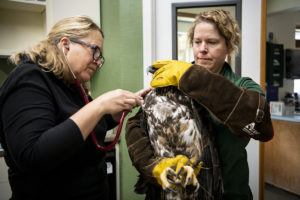
Lunch in the break room is often followed by a meeting, then it’s training time, with Miranda working with wiggly otters on the green tube behavior. Other days might see any of the keepers assisting at veterinary procedures, a vital opportunity for them to examine their charges close-up and discuss care with the veterinarian.
Giving the daily Keeper Chat and interacting with guests is also a big part of the job.
3pm
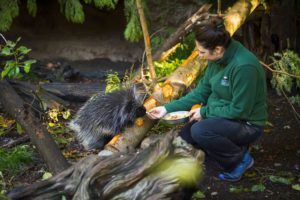
Everyone gets the late feed, Wendi makes her notes and her day is over at 3:30pm. Miranda remains.
“It’s busy,” Wendi says. “There’s no sitting down. But I like that, and working outside, even in 30 degrees. I just love seeing that connection between people and wildlife, and helping make that happen.”
MEET KEEPERS: Meet all our keepers and learn what they do at Zookeeper Academy, July 17-18.